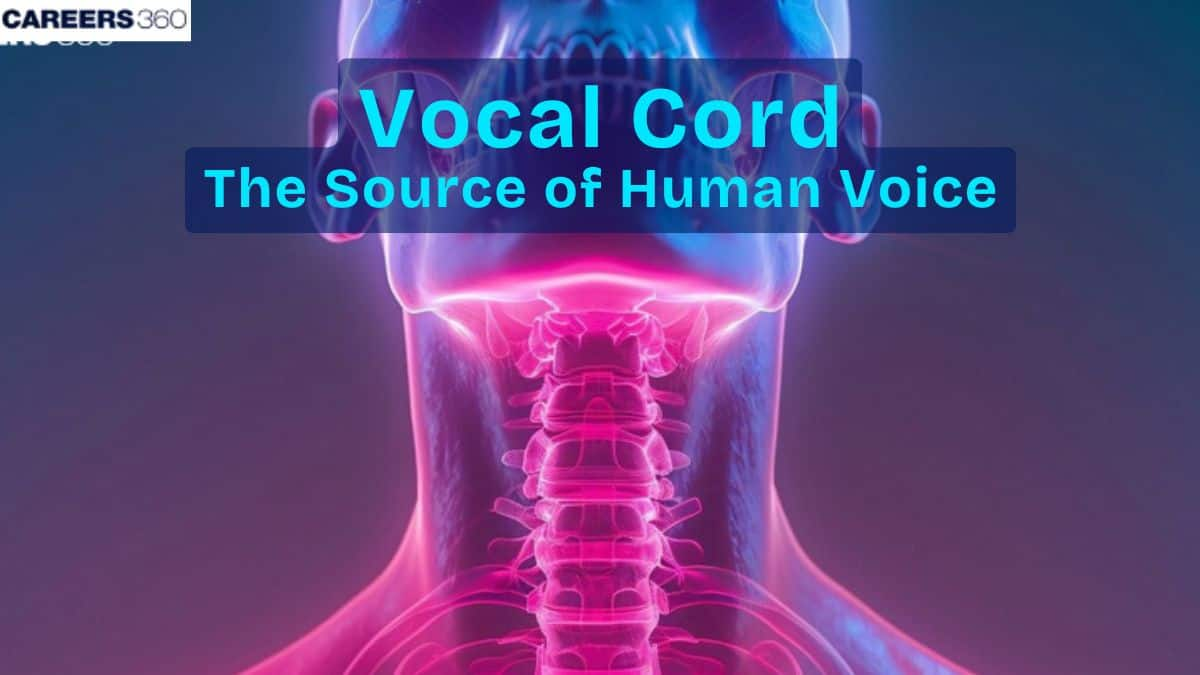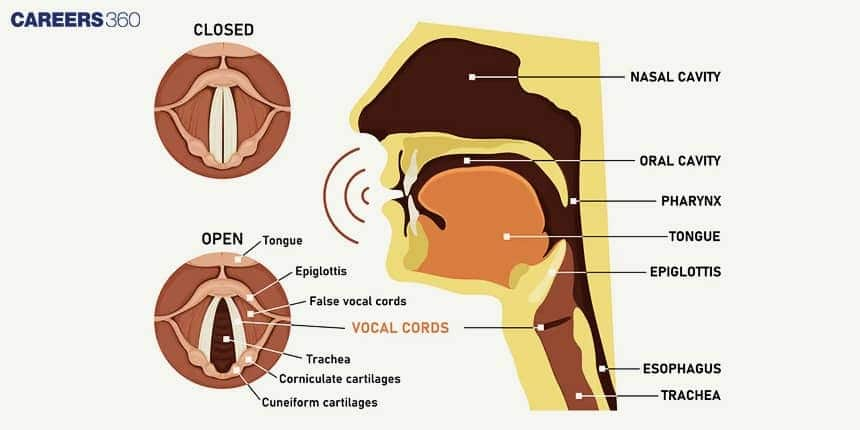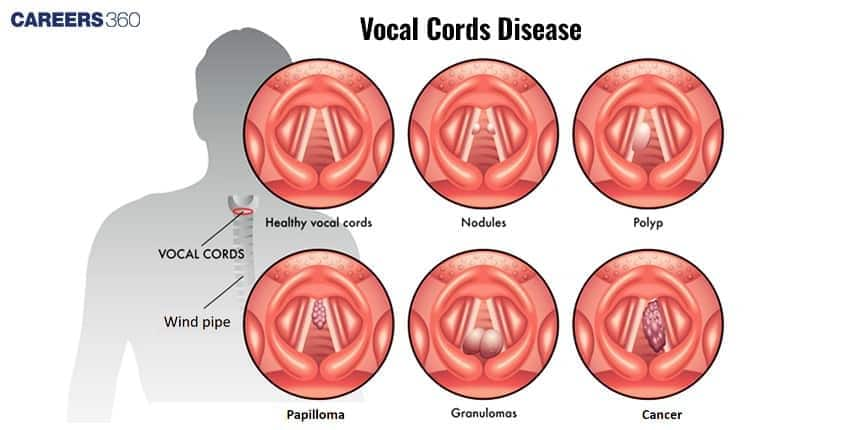Vocal Cord - The Source Of Human Voice: Anatomy, Function, Topics
Vocal cords, located within the larynx, are layered folds of tissue that vibrate to produce the human voice. They work with airflow from the lungs, resonating chambers, and precise muscular control to generate pitch and tone. Understanding their anatomy, physiology, and disorders is essential for NEET, physiology chapters, and voice science.
This Story also Contains
- What Are The Vocal Cords?
- Anatomy Of The Vocal Cords
- Physiology of Voice Production (Phonation)
- Factors That Affect Voice Production
- Common Disorders Of The Vocal Cords
- Diagnosis & Treatment of Vocal Cord Disorders
- Care & Maintenance Of Vocal Cords
- Advances In Vocal Cord Research
- Vocal Cords NEET MCQs (With Answers & Explanations)

What Are The Vocal Cords?
Vocal cords (vocal folds) are paired tissue bands inside the larynx that vibrate to create sound. They regulate airflow and pitch during phonation. The production of sound is an integral part of human communication and behind it is the very important role played by the vocal cord. The paper deals in detail with the anatomy, physiology, and care of the vocal cords to get insight into how they work as the source of the human voice.
Anatomy Of The Vocal Cords
The vocal cords consist of numerous layers: the epithelium, lamina propria, and vocalis muscle. All these layers make a sound-producing system. The vocal cords are located at the entrance to the trachea and are moreover covered by the thyroid cartilage.
Physiology of Voice Production (Phonation)
The principal components of phonation are listed below-
Role of Lungs (Power Supply)
The lungs are the power source of the voice, providing flow and pressure of air to enable the vibration of the vocal cords. Proper functioning of the lungs is thus crucial for the forceful and clear production of the human voice. Diaphragmatic breathing is a technique to maximize airflow potential from the lungs to support maximum vocal health.
Vibration of Vocal Cords (Vibrator)
It houses the vocal cords, which are the primary vibrator in the voice production process. As air is exhaled from the lungs, it will resonate with the vocal cords, producing a sound. Pitch can be varied by adjusting the tension and length of the vocal cords, and tone is changed similarly, thus allowing a great variety of vocal effects.
Resonance (Resonator System)
The vibration of the vocal cords produces sound, which is then amplified and modified in pitch, tone, and other acoustic features by the resonating chambers, including the throat, nose, mouth, and sinuses. These structures fine-tune the quality of sound and give an individual's voice its particular timbre or tone in a unique combination. Suitable resonance techniques will make the voice more projecting and clear.

Factors That Affect Voice Production
Several factors determine sound production.
Factors | Description |
Physiological Factors |
|
Environmental Factors |
|
Psychological Factors |
|
Common Disorders Of The Vocal Cords
Vocally, disorders do a great deal to misrepresent voice production. Commonly seen disorders include:
Nodules and Polyps
These nonmalignant growths may cause hoarseness or breathiness.
Laryngitis
It is an inflammation of the vocal folds, usually caused by an infection, often a result of overuse, that leads to hoarseness or loss of voice.
Vocal Cord Paralysis
This may be due to nerve damage and manifests with a weak, breathy voice producing trouble in speaking.

Diagnosis & Treatment of Vocal Cord Disorders
The diagnosis of disorders in the vocal cords typically includes laryngoscopy and stroboscopy, which allow visualization of the vocal folds. Treatment for each disorder would be different and could include the use of medicines, surgical interventions, and speech therapy.
Diagnostic Methods
Laryngoscopy: During this process, a small camera aids in the examination of the vocal cords to identify abnormalities.
Stroboscopy: This technique uses strobe light to show the vibration of the vocal cords in slow motion and gives appreciable detail of exactly how they are functioning.
Treatment Options
Treatments vary, and on occasions, simple rest combined with hydration is all that may be required. In most situations, voice therapy is extensively instituted for patients to learn better ways of using their voice to avoid undue strain on it.
Care & Maintenance Of Vocal Cords
Healthy ways of the vocal cords are one integral component in the production of the voice. Key practices include:
Hydration
Keeping the vocal cords well lubricated by drinking plenty of water.
Avoiding Strain
Avoid shouting or speaking loudly for long periods.
Proper Vocal Techniques
Applying proper breathing and speech techniques to avoid unnecessary straining.
Advances In Vocal Cord Research
Current research into the physiology of vocal cord problems has brought new insight and new remedies. Among the present innovations are improved surgical procedures and new forms of voice therapy. And to underpin it all, research studies into the complexities of the mechanics of vocal cord functioning and health continue.
Vocal Cords NEET MCQs (With Answers & Explanations)
Important topics for NEET are:
Vocal cord layers
Physiology of Voice Production
Factors affecting Voice production
Practice Questions for NEET
Q1. In man and mammals , air passes from outside into the lungs through
Nasal cavity , larynx , pharynx , trachea , bronchi , alveoli
Nasal cavity , pharynx , larynx , trachea , bronchioles , bronchi , alveoli
Nasal cavity , larynx , pharynx , trachea , bronchioles , alveoli
Nasal cavity , pharynx , larynx , trachea , bronchi , bronchioles , alveoli
Correct answer: 1) Nasal cavity , pharynx , larynx , trachea , bronchi , bronchioles , alveoli
Explanation:
Lungs: The branching network of bronchi, bronchioles, and alveoli comprise the lungs. The lungs are the primary organs of respiration, facilitating gas exchange to oxygenate the blood. The alveoli, tiny air sacs within the lungs, provide a large surface area for efficient diffusion of oxygen and carbon dioxide. The rhythmic contraction of the diaphragm and intercostal muscles aids in expanding and deflating the lungs during breathing.
Hence, the correct answer is option 4) Nasal cavity , pharynx , larynx , trachea , bronchi , bronchioles , alveoli
Q2. Which of the following options is incorrect about the larynx (sound box)?
It is a bony box
Glottis is the opening into the larynx
During swallowing of food glottis is covered by epiglottis to prevent food entry into the larynx
All of these
Correct answer: 1) It is a bony box
Explanation:
The pharynx opens through the larynx region into the trachea. The larynx is a cartilaginous box which helps in sound production and is hence called the sound box. It is situated behind the mouth and nose and joins the oesophagus (eating tube) and breathing routes (trachea [windpipe] and lungs) to the mouth (oral cavity).
Hence, the correct answer is option 1) It is a bony box.
Q3. A straight tube extending up to the mid-thoracic cavity is
Larynx
Pharynx
Trachea
Nostril
Correct answer: 3) Trachea
Explanation:
The trachea, a fundamental component of the respiratory system, is a tube extending from the larynx to the thoracic cavity, dividing into the right and left bronchi at the T4-T5 vertebral levels. It is approximately 10-12 cm long and 2-2.5 cm wide.
Structurally, the trachea is composed of C-shaped cartilage rings that are incomplete at the back, ensuring the tube remains open and uncollapsed during the respiratory process. This design also allows for flexibility near the esophagus, facilitating food passage. The trachea's interior is lined with a mucosal layer featuring ciliated pseudostratified epithelium and mucus-producing goblet cells. A submucosal layer beneath the mucosa contains connective tissue, blood vessels, and additional mucus-secreting glands. The outermost layer is the adventitia, which provides further structural support.
The trachea performs several critical functions, primarily the conduction of air to and from the lungs. Additionally, it filters incoming air, adding moisture and warmth through mucus production and the ciliated epithelium's actions. The mucociliary escalator mechanism moves mucus with trapped particles upwards, protecting the respiratory tract from inhalation of foreign substances.
Hence, the correct answer is option 3) Trachea.
Also Read:
Frequently Asked Questions (FAQs)
Newer surgical techniques and new voice therapy techniques are coming out. Further research work is going on and continues to enlighten the factors associated with the care of the vocal cords.
The vocal cords are two bands of muscle tissue located within the larynx, or voice box, at the upper end of the trachea.
Sound is produced when air from the lungs passes through the larynx causing the vocal cords to vibrate and produce sound waves.
Nodules, polyps, laryngitis, and vocal cord paralysis are common disorders.
Proper hydration of the body, avoidance of straining and improvement of methods of talking are the main ways of taking care of your vocal cords.